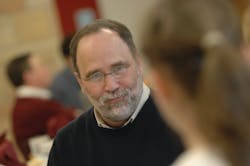In a long, windowless, fluorescent-bright room at the Fargo Jet Center, surrounded by two long benches filled with equipment and panels for radar tests, transponder tests, nav and com radio tests, Dave Mohn sits on a stool that can roll off by itself where the floor slopes. Baseball cap on his head, gray beard barely hiding the grin on his face, he’s the kind of person you tend to like right away.
Mohn’s history and experience are deep. Most of the test panels he built himself. He’s worked on everything from 1942 Cubs and 1939 Skyrangers to the new King Airs and Challenger 604s. Mohn began his career as an avionics technician in 1979 at Pietsch Flying Service in Minot, ND. He later moved to Waypoint Avionics in Fargo, which was then acquired by the Fargo Jet Center. Mohn is an avionics bench technician. If you bring him an airplane instrument, he is authorized to open and repair it all the way down to the component level — the individual transistors and resistors. This morning he’s already finished complete inspections on five or six radios.
His talent with radios and instruments and electronics is extraordinary. But that’s not why people smile when you say his name. Mohn is one of those people who believe in service, in mentoring kids, who believe in making a real difference. As a merit badge counselor for the Boy Scouts of America, he has recently seen his 275th scout earn the Aviation Merit Badge.
How it began for Mohn
Dave Mohn grew up in Moorhead, MN. His family background is Norwegian, but Mohn was the name given to his family at Ellis Island. “Our Norwegian name wasn’t even close to Mohn,” he says. “That’s just what someone came up with. All the other Mohns we know are German.” Like many school kids, Dave was asked in his 9th grade social studies class to think about his future vocation. He loved electronics. He also loved airplanes. “I used to watch them go by all the time,” he says. “I still do.” His teacher gave him an FAA pamphlet that described a career in aviation electronics and he was hooked.
“I had my intro flight when I was 16,” he says. "I don’t have a pilot’s license, but I do have about 35 hours as PIC. And because I do all the certification and recertification flights, I sit in the right seat all the time. I have more hours in the right-seat than most pilots have in the left!” When I ask him why he never finished his private pilot’s license, Mohn tells me he has two children, both with Muscular Dystrophy and one with aspergers syndrome. His wife, who also has Muscular Dystrophy, and he have adopted two children with special needs as well. “My time, effort, and energy went to my kids,” he says, proudly.
Scouting as a means of creating aviation interest
Mohn himself was never a Boy Scout. “I wish I would have been one,” he says. One day several years ago, however, a friend of his son’s invited his son to a Boy Scout camp-out. Dave’s wife wanted Dave to go along. “Once I got involved, it was all over. Every time I was around kids it was a lot of fun,” he says. “I was always trying to create a positive atmosphere.”
Mohn remembers the first aviation merit badge he guided. It was in 2005. Troop 244 from North Fargo. Dave helped the scouts built a wind tunnel out of Lexan glass for a Scout Show at Moorhead, MN, Center Mall, a gathering of dozens of Boy Scout troops that showcases projects and activities. That air tunnel took Best-in-Show and is still on display at the Fargo Air Museum.
His most recent group of students was just last week. Fifteen students from Troop 68 in Long Prairie, MN, and Troop 222 in Fargo, ND, appeared at the Fargo Jet Center to work on their Electronics and Aviation badges.
The Aviation merit badge
The Aviation merit badge is one of the original 57 Boy Scout merit badges offered in 1911. To earn the badge, a scout has to complete 10 activities which range from a preflight inspection to explaining how an airfoil creates lift, from creating a flight plan with destination times to building a gas-powered model airplane, from visiting a tower to visiting the FAA. It’s not an easy merit badge to earn.
Mohn has acted as mentor, or counselor, for more than 275 scouts who have earned this badge. He’s acted as counselor for more than 150 merit badges in electronics. In fact, he has been the adult behind more than 700 merit badges including hiking, small boat sailing, personal fitness, communications, orienteering, and more. In 2010, he helped more than 300 boys earn their Centennial badges for Signaling, the old arts of communicating by semaphore flags and Morse Code. Fifty-seven of them earned the badge in one weekend. “You help them get there. That’s what you do,” he says. “You get to have a significant impact on kids. That’s why I do it.”
I ask Mohn about his most memorable badge. “I was sitting on an Eagle board, the panel of Scout leaders who review the applications of young men who want the rank of Eagle Scout — the highest rank we have” he says, “and, as always, we asked the boy about his career aspirations. He said he wanted to be an aerospace engineer. I looked and I could not see the Aviation badge. It was way down on the sash — one of the more recent ones in this boy’s scout history. I asked him about the badge and he showed it to us, and then reminded me that I was the mentor for his project. He said he had thought he was going into civil engineering. But his experience with the aviation badge really lit a fire and changed his mind.” Dave pauses and says, “That was exciting!”
Mohn has had significant career influence in a great many Scouts. “When the lightbulb goes on, you can almost see it happen,” he says. “That’s a wonderful moment.” Another project he recalls happily was another Eagle project. The Scout built a display table with a laminated Sectional Map on top and a CDI built into the wood. You could manipulate the CDI and set up all sorts of approaches. The scout put about 170 hours into it. Mohn put about 25 hours into it himself. “Eagle Scout project are big at the Fargo Air Museum,” he says.
Perhaps his greatest thrill, however, was at Camp Wilderness, a Boy Scout camp in the Minnesota northwoods. “I saw a boy who was not participating at all,” Mohn says. “He just sat there, a bit off by himself. I sent one or two of the older boys over that way to see what was wrong, then I went over myself. He said he really wanted to be working on a different merit badge — not aviation — but the other class had a cap on the number of scouts and it was full by the time he tried to register. That’s fine, I said, I certainly understand that. But I told the kid he should at least get the aviation badge for all the time he had to spend sitting there. The scout agreed and in fact came up to me at the end of camp and said that badge was the most fun he had in his entire scouting career. As a matter of fact, at the end of that camp, every student said thank you.”
Mohn and I tell stories of other scouts and other projects until he has to get back to work. Every story is special. Every scout seems remembered. Before he turns back to work he grins one more time. “It’s just so much fun,” he says.

